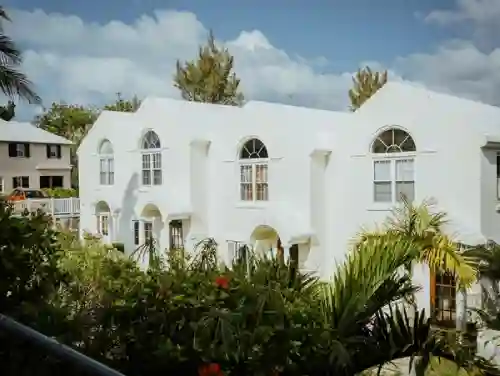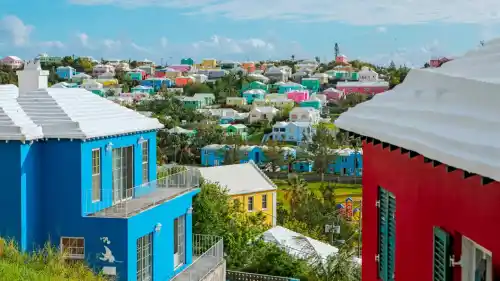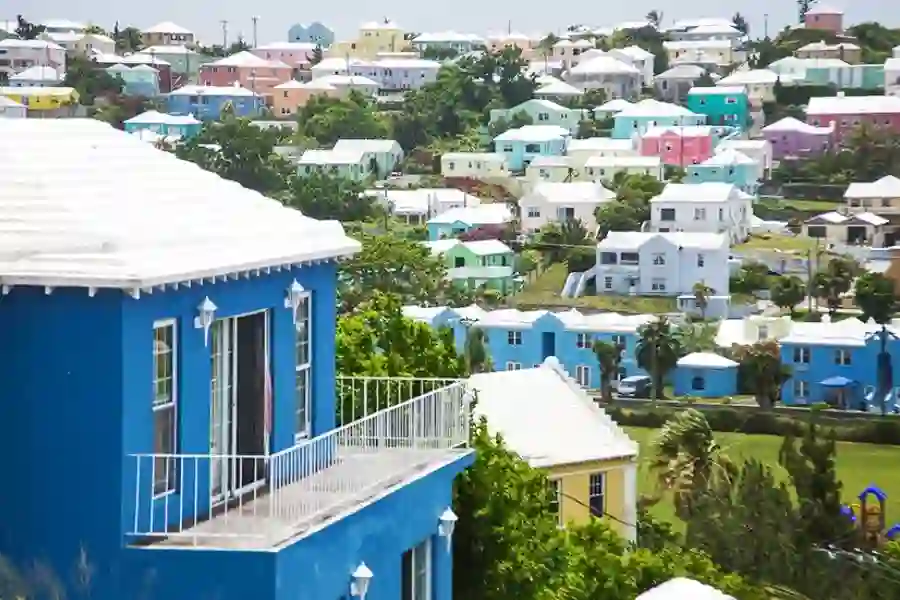Best known for its beautiful beaches, clear blue waters, and the charming appeal that draws everyone who visits; Bermuda. First of all, the most iconic characteristic is colorful houses. So why are the houses in Bermuda colorful? It is a question that many tourists and architectural enthusiasts find themselves asking. Through history, culture, and climate adaptation as well as its current architectural ecology, the island of Barbados is a blend of references – Here we trace those aesthetics.
In this deep dive, we will consider the roots of Bermuda homes so colorful through their style and prominence as well as how they combine to produce such picturesque environments for which Bermuda is notorious.
Key Takeaways
- Historical Roots: The tradition of colorful houses in Bermuda has deep historical roots, influenced by colonial practices and local culture.
- Climate Adaptation: The colors and Bermuda roof designs are practical adaptations to the island’s unique climate.
- Cultural Significance: Bright colors reflect Bermuda’s vibrant culture and community spirit.
- Modern Influences: Contemporary trends in modern Bermuda architecture continue to evolve while honoring traditional elements.
The Historical Roots of Bermuda’s Colorful Houses
Bermuda first saw the tradition of colorful houses during colonial times, later spreading through towns and filling them with color. Homes in Bermuda were traditionally constructed using local limestone that could be found here when the island was first settled back in 1609. Yet somewhat, unfortunately, this limestone tends to grey as it starts weathering over time. Early settlers started to paint their homes with bright lime washes, a method they borrowed from European architecture to fight this.
The Influence of Colonialism
Colonialism has long taken a hand in the architectural direction of Bermuda. It is a collection of disparate brick towers built by early British settlers following the example of their homeland but in ways suitable for constructing on an island with a subtly milder climate. The lime washes weren’t just beautiful; they were practical. The bright colors were also used to reflect sunlight, which helped reduce houses’ early AC bills in Bermuda’s warm summers.
Bermuda’s colorful houses also served as a form of social expression. In the early days, the color of a home could signify the owner’s wealth or status within the community. Wealthier families could afford more expensive pigments, while others used whatever materials were available. Over time, these colors became a beloved feature of Bermuda’s architectural landscape.
The Evolution of Colors Over Time
With centuries following, the trend of bright house painting became evolved within itself. The pigments that have been used in the paint have evolved and changed over time with new colors following contemporary trends. In the current days, beam houses are used in quite a few hues from pastel pinks and yellows to deep blues and greens. Not only are these colors just pure eye candy, but they also epitomize a long and storied past that remains with us in many of the same architectural trends found on buildings today.
Climate Adaptation: The Role of Color and the Bermuda Roof
The island’s architecture is a direct result of its unique climate. Under their relentless sun and the warm, humid air that reigns throughout most of Southeast Asia, homes have to be as unobtrusive in design as possible while also being practical. One of them is to use bright colors, which are perfect for reflecting the intense solar rays and therefore allow more heat diffused by buildings.
The Practicality of Bright Colors
On the other hand, in Bermuda, you need something bright not just to stand out a bit more but because it is practical. Light colors reflect sunlight better than darker paints, which means it makes your home cooler. This is particularly crucial in Bermuda with the scorching summer temperatures. The colorful houses reflect sunlight (darker colors absorb heat) and, according to one of the architects who designed them, that means they require less air conditioning—contributing to energy savings.
The Bermuda Roof: An Ingenious Architectural Feature
One of the most unique features of Bermuda-style houses is the Bermuda roof. This unique roofing style is marked by stepped, whitewashed limestone tiles. The design is not only visually impressive but also incredibly practical. The stepped design helps to capture rainwater, which is then purified and stored in cisterns under the house. Given that Bermuda has no natural freshwater heads, this rainwater collection system is important for the island’s residents.
The Bermuda roof is often paired with the bright colors of the homes, making a stunning contrast that is both beautiful and useful. The white roofs, like the bright house colors, reflect sunlight, contributing to the overall cooling effect. This clever combination of form and process is a hallmark of modern Bermuda architecture.
Cultural Significance: Expressing Bermuda’s Vibrant Spirit
Bermuda’s colorful houses are more than a response to the climate; they speak volumes about Bermuda, its people, and its community spirit. Residents use the vibrant reds, greens, and yellows as a method of displaying their unique selves and investment in their properties.
A Community Tradition
Painting houses in bright vibrant colors has been a longstanding tradition that not only adds some character to Bermuda. Homeowners are free to select any color, I mean what suits their taste or style resulting in a colorful outlook island-wide. This has built a community spirit with many residents enjoying their vibrant location.
Symbolism in Colors
The colors that people paint their homes in Bermuda tend to hold a lot of symbolic significance. For instance, blue is a color many people choose as it embodies that Ibiza feeling and association with the sea. Pink is popular, which represents Bermuda’s streams of pink sands. The color of the homes is not just a matter of preference, but it gives residents an opportunity to display their island pride and link home with its surrounding nature.
“The colors of Bermuda’s houses are a reflection of the island’s culture—vibrant, warm, and full of life.” – Local Architect
A Tourist Attraction
The bright, colorful homes in Bermuda have become one of the biggest draws for tourists from around who love to visit the island and marvel at its distinct style. Visitors commonly note the cheerful and picturesque colorful houses since they have come to define Bermudian culture. The island’s all-important tourism industry has fully embraced this, billing the pastel houses as a sight worth seeing for anyone coming to Bermuda.
The Impact of Modern Bermuda Architecture on House Colors
While Bermuda’s colorful houses have serious historical roots, they have not stayed static. Modern Bermuda architecture persists in evolving, bringing new trends and results to the island’s architectural terrain. These modern forces have affected the colors used on homes, as well as the general design of Bermuda-style houses.
Contemporary Color Trends
Housing colors in Bermuda have trended toward muted, pastel looks. While these colors are still vivid and playful, they provide a subtler take on the brights we all know so well. This trend reflects wider movements in different countries where softer colors have become more common. Nonetheless, the use of bold colors still exists, even in more conservative neighborhoods.
This mixture of the traditional and contemporary results in a changing architectural facade, where past and present sit side by side—quite literally.
Innovation in Materials and Design
Modern Bermuda architecture has also seen creation in the materials and methods used in building homes. While traditional limestone is still popular, modern homes may include other materials such as tangible or synthetic roofing tiles. These materials can be painted in the traditional bright colors or the newer pastel hues, allowing homeowners to maintain the aesthetic appeal while taking benefit of modern construction methods.

The incorporation of modern design features, such as larger windows and open-plan interiors, has also affected the colors used on the exterior. Homeowners are now considering how the color of their home interacts with the interior design, leading to more cohesive and brilliant color choices.
Environmental Considerations
As understanding of environmental issues increases, there has been a shift towards more tolerable practices in modern Bermuda architecture. This includes the use of eco-friendly paints that are free from toxic chemicals. These paints are available in a wide range of colors, allowing homeowners to keep the island’s vibrant aesthetic while underestimating their environmental impact.
The Bermuda roof has also seen modern transformations, with some homeowners choosing to install solar panels or other renewable energy plans. These modern updates do not detract from the classic appearance of the roof, allowing homes to retain their traditional Bermuda style while adopting new technologies.
The Role of Government Regulations in Maintaining Bermuda’s Aesthetic
The quaint homes with a unique architectural flavor of Bermuda are not just random individual choices; they live in the color and style for which Bermuda is famous due to regulations by the government. The Bermuda Government has created numerous building codes and guidelines to protect the island’s unique design.
Building Codes and Color Regulations
The Bermuda Government has very strict rulings on the colors of outside homes. These regulations ensure the island keeps its classic visual and that colors which would look out of place in Bermuda’s naturally beautiful architectural surroundings are not used.
Homeowners will be able to choose from a spectrum of approved colors, many bright. It is these regulations that currently keep the traditional Bermuda look alive in contemporary architecture. Bermuda maintains its individuality with traditional colorful homes.
Preservation of Historical Buildings
The Bermuda Government protects those properties, not only via its regulation of new-build projects but also through a conservation ordinance that focuses on historic building assessments. To maintain the charm and character of these homes, many are historical landmarks in Bermuda—meaning any refurbishments or renovations carried out on them must follow certain guidelines. This way, the island can still protect its architectural heritage for future generations to witness.
Encouraging Sustainability
In addition, the Bermuda Government encourages responsible building with incentives and regulations to promote sustainability. Homeowners that utilize sustainable materials or integrate systems for renewable energy in their residences can collect on numerous incentives. The attention to sustainability matches with the environmentally conscious direction of Bermuda as well as the protection of its special architecture.
The Global Influence of Bermuda’s Colorful Architecture
The colorful houses of Bermuda are a part of what gives the island its unique identity, and their charm has influenced an eclectic range of architectural styles. The Bermuda house style has turned into a recognizable emblem of tropical construction, affecting styles on some other islands as well as coastal areas.
Exporting the Bermuda-Style
Bermuda’s architecture has been widely copied in adapted forms by other lands that share its climate, especially Bermuda’s distinctive white-stepped roofs. In the Caribbean and areas of the southern United States with similar climates, architects have copied Bermuda’s architectural tradition.
These are represented through the bright tinge of colors, stepped roofs, and locally crafted materials in construction. Although often tailored to fit regional constraints, the Bermuda influence on their style is unmistakable.
Bermuda as a Model for Sustainable Architecture
Inventive applications of the Bermuda roof as a rainwater catchment have garnered global interest from builders and environmentalists alike. These methodologies used in Bermuda are currently under study to be incorporated into different areas because of how significant water shortage is becoming a concern. As of now, Bermudian architecture is considered to be a demonstration for other communities facing similar challenges by merging traditional designs with modern sustainability practices.

Inspiration for Designers and Artists
Beyond architecture, Bermuda’s colorful houses have motivated artists, designers, and creatives around the world. The vibrant colors and unique methods of Bermuda-style houses are often featured in art, fashion, and interior design. This global force has helped to further cement Bermuda’s prestige as a hub of imagination and innovation.
FAQs People Also Ask
Why Are the Houses in Bermuda So Colorful?
The houses in Bermuda are colorful due to a variety of historical practices, climate adaptation, and cultural presentation. The tradition began with the use of lime washes to light limestone buildings and has grown into a cherished cultural tradition.
What Is the Architectural Style of Bermuda?
The architectural style of Bermuda is represented by the use of local limestone, the typical Bermuda roof, and vibrant colors. This style recalls both the island’s colonial history and its transformation to the local environment.
What Is the Purpose of the Bermuda Roof?
The Bermuda roof is designed to catch and filter rainwater, which is stored in cisterns for home use. The stepped design also helps to remember sunlight, keeping homes cooler.
How Does Modern Bermuda Architecture Differ from Traditional Styles?
Modern Bermuda architecture incorporates modern design elements and materials while retaining traditional features like the Bermuda roof and vibrant colors. There is also a growing focus on sustainability in modern building.
Are There Regulations on House Colors in Bermuda?
Yes, the Bermuda Government has rules that dictate the colors that can be used on houses. These rules are designed to keep the island’s traditional aesthetic and ensure that new buildings align with the island’s architectural legacy.
Final Words
So, the color is much more than just a picturesque backdrop: Bermuda’s colorful houses are symbolic of the richly-hued history and culture of an island that continues to break new ground. The Bermuda roof is not only practical, but the color selection tells you something about the person who lives there, embodied in these examples of Bermudian architecture.
While you are traipsing the by-lanes of Bermuda, soaking in its many colorful sights, or catching a view far from some beautiful vantage, take time to appreciate how these homes add up so well with little nuances that reflect a slice of Bermuda’s own identity and heritage. The mixing of old and new within the modern Bermuda architectural style guarantees residents can still embrace this vibrant tradition for years to come, both visitors and locals.
Have you seen those colorful houses yourself before? What was your impression? Let us know what you think, and read our post to see more of Bermuda´s incredible culture, with the English traditional houses!

